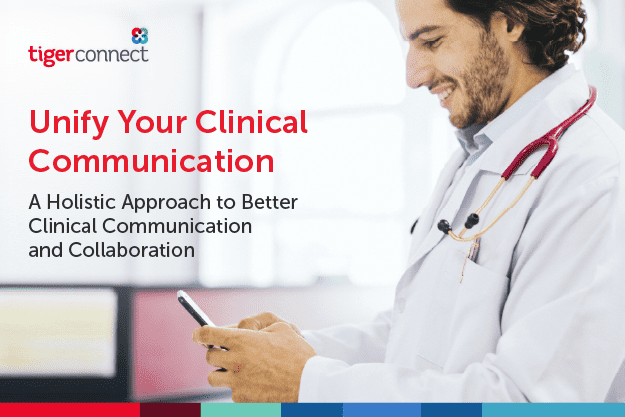Home / Blog /
Maximizing Efficiency and Quality of Care: Understanding Clinical Workflows

Maximizing Efficiency and Quality of Care: Understanding Clinical Workflows
Here’s a sobering thought: 30 percent of all medical malpractice lawsuits today came as the result of poor clinical workflows. These inefficient workflows not only resulted in costs exceeding $2 billion but also caused nearly 2,000 deaths.
Whether it’s a Code Blue situation or a patient transfer, the ability to conduct seamless clinical communications across providers and facilities has never been more critical. It’s estimated the healthcare industry is treating more patients than ever before – with 145 million hospital emergency room visits yearly in the US resulting in 35 million hospitalizations.
Unfortunately, the current healthcare system wasn’t designed to handle this volume of patients. To treat patients more effectively, the industry has embraced the use of modern communication technology to support and connect care teams, including primary care physicians, specialists, and multiple facilities, communicating and collaborating to manage patients and better manage demanding workloads.
The complexity is exacerbated by outdated clinical workflows trying to incorporate siloed information, outdated technology, disparate systems, and poorly integrated communication and collaboration. But to power more effective patient diagnoses, lighten clinical casework, and lessen errors, a holistic clinical workflow must include seamless collaboration across facilities, doctors, and specialists. That’s easier said than done.
Unify Your Clinical Communication
Learn how a dedicated clinical communication and collaboration platform can improve clinical workflows.
|
 |
Understanding Clinical Workflows
The National Institutes of Health define clinical workflows as holistic processes involving a range of tasks carried out by multiple people and facilities to deliver care. Each task may require one or multiple people – taking place sequentially or simultaneously. This seamless and timely information flow is essential for care teams to collaborate effectively, make informed decisions and ensure patients receive quality care.
Just imagine the potential interactions required for a single hospital visit. A patient reaches the emergency room. In a short period of time, they must be diagnosed and triaged, potentially admitted, transferred across nurses and care professionals, referred to a specialist, undergo labs and x-rays, and then perhaps moved to another facility. During this time, records must be transferred, caregivers must communicate with one another, clinical options must be discussed and explored, and effective treatments administered. And because lives are potentially at risk, every second counts.
Digital information sharing is a critical component of the healthcare system, as it ensures that every member of the care team can coordinate effectively and ensure the best possible outcome for patients. Unfortunately, too often consults or procedures are subject to delays which can cause disruptions to patient care and increase hospital length of stays (LOS). A recent study on 316 patients revealed that over 50 delays occurred due to consultations or procedures, with an average delay increasing LOS by 1.8 days. The most common reasons behind these delays included scheduling difficulties and late responses to pages. To minimize these avoidable delays, healthcare providers must strive to improve communication across teams and ensure timely response to requests for information.
Diagnosing More Effective Clinical Workflows
The key to optimizing clinical workflows is an integrated clinical communication and collaboration platform that gets the right information to the right person at the right time. Clinical communication and collaboration platforms make it possible to streamline workflows, ease communications across providers and share critical patient information such as treatment plans, medical history, and medications. CC&C platforms enable real-time communication between care teams working across rapidly changing scenarios.
The efficiency and effectiveness of clinical workflows are significantly enhanced by a comprehensive, unified platform that seamlessly integrates various healthcare communication technologies. The TigerConnect Clinical Collaboration Platform exemplifies this by integrating numerous essential healthcare systems, such as Electronic Health Records (EHR), Laboratory Information Systems (LIS), nurse call, and patient monitoring systems, into a single mobile solution.
Furthermore, it encompasses a wide range of functionalities, including clinical collaboration, alarm management, physician scheduling, and patient engagement. By incorporating these features, the platform empowers interdisciplinary care teams to streamline their communication, expedite decision-making and patient treatment, and ultimately improve patient outcomes. With role-based and group messaging capabilities, TigerConnect fosters faster response times and enhances the overall efficiency of healthcare delivery, ultimately leading to decreased length-of-stay, reduced costs, and better patient experiences.
Solutions like TigerConnect are designed to address these challenges to unlock the true potential of clinical collaboration – specifically designed for the new world of digital healthcare information. This not only helps improve patient outcomes, but also reduces the burden on doctors and hospitals – helping to coordinate the right care team to improve efficiency, quality of care, and throughput, and enabling faster response times for critical situations.
Taking the Next Step
The healthcare ecosystem is truly being pushed to its limits, hospitals are doing more with less staff and with an unprecedented number of patients, providers, and facilities must work hard to keep pace. But there is light at the end of the tunnel.
By adopting integrated clinical communications and collaboration, the industry can more effectively streamline communication, ease workflows and provide more effective patient care. Start exploring how clinical communications and collaboration can help navigate the increasingly complex healthcare ecosystem by downloading our guide, “Leveraging Modern Communication Technologies to Improve Workflows”. Every second counts…Why not take the next step?
Ryan Bush, MSN, RN-BC, Clinical Nurse Consultant
Ryan Bush is a Clinical Nurse Consultant at TigerConnect with over 14 years of experience in a variety of healthcare roles including bedside nurse, clinical applications analyst and most recently a manager of nursing informatics for the Cleveland Clinic in Cleveland, OH. Ryan holds a Masters and board certification in the field of Nursing Informatics.
Tags: Clinical Communication and Collaboration, Clinical Workflows








